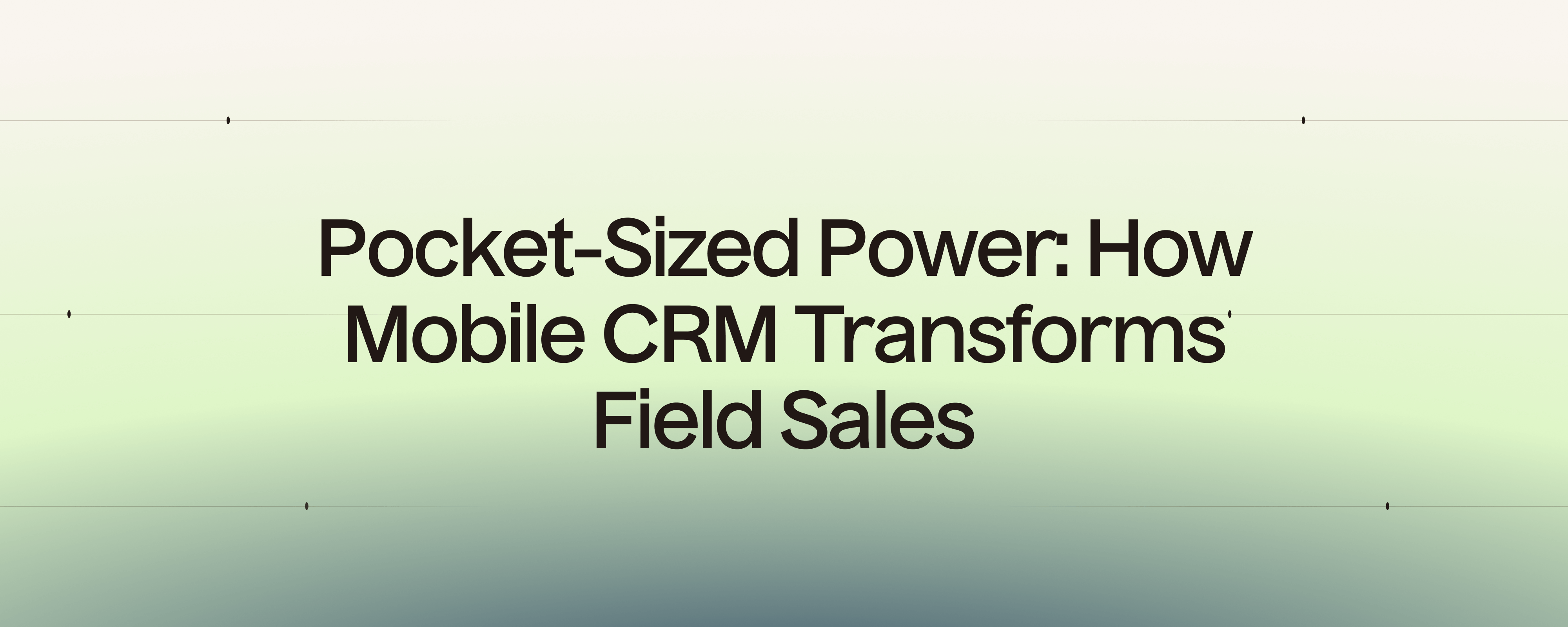In-person engagement is more valuable than ever. As digital fatigue sets in and inboxes overflow, face-to-face interactions remain the most effective way to build trust, capture leads, and drive revenue. But not all in-person strategies are created equal. Terms like In-Person Marketing (IPM), Event Marketing, and Field Marketing are often used interchangeably, yet each plays a distinct role in a modern go-to-market strategy. Understanding these differences is critical for sales and marketing teams aiming to maximize ROI from every real-world interaction.
Why Distinguishing IPM, Event Marketing, and Field Marketing Matters
The global events industry is projected to grow from $1.4 trillion in 2024 to $2.3 trillion by 2034[1]. As budgets shift back to in-person, the pressure is on to prove ROI. Teams that treat every handshake, badge scan, and business card exchange as a strategic opportunity outperform those stuck in outdated, siloed approaches. Knowing the difference between IPM, Event Marketing, and Field Marketing helps you assign the right resources, invest in the right technology, and design smarter sales enablement strategies.
What Is In-Person Marketing (IPM)?
IPM is a channel, not a team or a one-off tactic. It covers every face-to-face interaction—planned or spontaneous—across sales, marketing, and partnerships. The defining feature of IPM is its focus on real-world engagement, powered by digital tools that make every interaction measurable and actionable.
Key Traits of IPM
- Channel-based: Used by sales, marketing, and partnerships
- Always in-person: Every real-world interaction counts
- Technology-driven: Relies on tools for lead capture, enrichment, and CRM sync
- Scalable: Works across teams and locations
Example
A sales rep uses Popl’s universal scanner to capture a lead at a networking dinner. The contact is instantly enriched and synced to the CRM, ready for immediate follow-up.
Why IPM Is the Next Evolution
IPM takes the core idea of event marketing—connecting with people in real life—and turns it into a system for revenue generation. With platforms like Popl, teams gain full ownership of their data, automate follow-up, and attribute in-person activity directly to pipeline and revenue[[1]][[2]].
“Event marketing is a piece of the puzzle. IPM is the whole system that makes the puzzle complete.”[[1]]
What Is Event Marketing?
Event Marketing is a function or team focused on planning, promoting, and executing events. These can be in-person, virtual, or hybrid, and are typically large-scale, centrally managed experiences designed to build brand awareness and engage prospects.
Core Characteristics of Event Marketing
- Function/team-based: Owned by a dedicated events team
- Event-centric: Focused on specific, scheduled gatherings
- Multi-format: In-person, virtual, or hybrid
- Brand-focused: Prioritizes awareness and engagement
Example
Your company sponsors a major industry conference, hosting a branded booth and running a product demo session.
Event Marketing’s Role
Event marketing is about orchestrating experiences that put your brand in front of the right audience. Success is often measured by booth traffic, badge scans, or session attendance. However, traditional event marketing can be transactional, with limited follow-through and delayed lead processing[[1]][[2]].
What Is Field Marketing?
Field Marketing is a regional, sales-aligned discipline. Field marketers execute tailored programs in specific territories, working closely with local sales teams to drive pipeline and revenue. They blend in-person and digital tactics, often owning end-to-end program execution.
Key Traits of Field Marketing
- Regionally owned: Managed by local field marketing teams
- Sales-aligned: Deep partnership with sales for pipeline impact
- Multi-channel: Combines in-person and digital tactics
- Metric-driven: Focused on pipeline generation and sales enablement
Example
A field marketer in Boston organizes a healthcare executive dinner, followed by a targeted ABM campaign and local follow-up meetings.
Field Marketing’s Strategic Value
Field marketing bridges the gap between national campaigns and local sales needs. It’s about executing go-to-market programs that resonate in specific markets, driving measurable results[[3]][[4]][[5]].
Side-by-Side Comparison: IPM vs. Event Marketing vs. Field Marketing
| Criteria | In-Person Marketing (IPM) | Event Marketing | Field Marketing |
|---|---|---|---|
| Definition | Channel for face-to-face engagement | Function/team for event execution | Regional function for GTM programs |
| Format | Always in-person | In-person, virtual, or hybrid | Hybrid: in-person + digital |
| Ownership | Cross-functional | Centralized events team | Regional field marketing team |
| Goal | Engagement, data capture, revenue | Brand experience, engagement | Pipeline generation, sales alignment |
| Technology Reliance | High (lead capture, CRM sync) | Medium-high (event tech) | Medium (ABM, CRM, event tech) |
| Sales Alignment | Varies (often tactical) | Low to moderate | High (close sales partnership) |
How Popl Powers Modern In-Person Marketing
Popl is the leading In-Person Marketing Platform, designed to make every real-world interaction count. Here’s how Popl stands out:
- Universal Lead Capture: Scan badges, business cards, and QR codes with a single app—no need for multiple systems.
- AI-Powered Enrichment: Instantly enrich contact data for more effective follow-up.
- Real-Time CRM Sync: Leads flow directly into your CRM, even when offline, eliminating manual entry and delays.
- Seamless Team Enablement: Equip sales, field, and event teams with digital business cards and unified lead management.
- Actionable Analytics: Attribute in-person activity to pipeline and revenue, proving ROI on every handshake.
Example: At a trade show, your team uses Popl to scan attendee badges. Each lead is enriched, segmented, and routed to the right rep in real time, ready for immediate action.
When to Use Each Approach
- IPM: For organizations that want to maximize every in-person interaction, from trade shows to spontaneous meetings, and need full data ownership and instant CRM integration.
- Event Marketing: For building brand awareness and orchestrating large-scale experiences, especially when virtual or hybrid formats are involved.
- Field Marketing: For driving pipeline in specific regions, aligning closely with local sales, and executing tailored programs.
Key Takeaways for Sales and Marketing Teams
- Assign the right team to the right job: Don’t expect your event team to handle regional sales enablement, or your field team to run global conferences.
- Invest in the right tech stack: Choose platforms that unify lead capture, enrichment, and CRM sync across all in-person channels.
- Avoid overlap and confusion: Clear definitions and ownership prevent wasted effort and missed opportunities.
- Design smarter GTM strategies: Align channel, function, and region for maximum impact.
Frequently Asked Questions
What’s the best way to capture leads at events?
Use a universal lead capture tool that scans badges, business cards, and QR codes, enriches data, and syncs directly to your CRM. Popl offers this functionality in a single platform.
How does IPM improve ROI compared to traditional event marketing?
IPM provides full data ownership, instant CRM sync, and automated follow-up, making every in-person interaction measurable and attributable to revenue[[1]][[2]].
Can field marketing be fully digital?
Field marketing is most effective when it combines digital tactics with in-person engagement, tailored to local markets[[3]][[4]][[5]].
How does Popl compare to other lead capture solutions?
Popl is the only platform offering universal scanning, AI-powered enrichment, and real-time CRM integration in one app, supporting sales, field, and event teams.
Conclusion
IPM, Event Marketing, and Field Marketing each play a unique role in your go-to-market strategy. IPM is the channel that turns every in-person interaction into a revenue opportunity. Event marketing is the engine for orchestrated brand experiences. Field marketing is the regional execution layer that drives pipeline where it matters most. The most successful teams in 2025 connect these approaches, using platforms like Popl to make every handshake count.
Ready to make your in-person marketing measurable and impactful? Book a Popl demo today.













